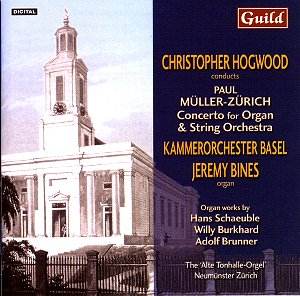The four composers represented in this interesting
selection of Swiss organ music from the first half of the 20th
Century are all roughly contemporary, although Paul Müller-Zürich
is the ‘Grand Old Man’ here. He is also the only one to be
represented by two works of his early maturity. The short and
quite brilliant Toccata in C Op.12 displays the
composer’s Neo-classical leanings, still more evident in the beautiful
Organ Concerto Op.28, completed in the late 1930s
and revised as late as 1978. Here is music of formal clarity and
harmonic refinement, by turns lyrical (as in the beautiful slow
movement) and rhythmically alert and lively (as in the outer movements).
It is effectively and economically scored for organ and strings,
which makes it a perfect companion piece to Poulenc’s masterly
Organ Concerto in G. In spite of some common characteristics,
both pieces are of an essentially different musical and emotional
character and, as such, complement each other.
Willy Burkhard’s name may be more familiar,
although – I am afraid – his music is not, at least outside Switzerland.
His Sonatina Op.52, composed in 1938, is in the
typical Neo-classical mould, and has much in common with Müller-Zürich’s
concerto. Again, formal clarity, clear-cut themes, refined harmonies
and lightness of touch are much in evidence in a delightful work
that should definitely be heard more often.
However, Adolf Brunner’s first major organ
work Pfingstbuch über den Choral "Nun bitten wir
den Heiligen Geist" (to give it its full title) completed
between 1936-1937 is the most substantial work here. It may globally
be considered as a large-scale fantasy in variation form on the
Whitsun chorale. Its multi-sectional structure is intricately
worked-out. The chorale is stated after a short preamble based
on the chorale. There follows a partita and a weighty passacaglia
capped by a restatement of the chorale. Though it is, musically
speaking, fairly traditional, Brunner’s music is characterised
by clarity of form and often transparent harmonies. This is a
significant work and an impressive achievement. The excellent
insert notes mention this as the first of Brunner’s four major
organ works, and I hope that Jeremy Bines and Guild will go on
recording the others.
Hans Schaeuble may be familiar, though
his music does not often feature either in concerts or in recordings.
A few months ago, though, Guild released a fine disc of Swiss
concertos for wind instruments including Schaeuble’s finely wrought
Concertino for Flute and Strings Op.47 (Guild GMCD
7250). His Präludium Op.15 (or rather "from
Op.15") recorded here is what remains of a large-scale work
with the collective title of Geistliche Abendmusik
which consisted of an organ Introduction (later re-titled
Präludium), a cantata, choral variations for organ
and a motet. The composer was seemingly dissatisfied with the
work as a whole but has retained a real liking of the majestic
Prelude, which he revised on several occasions. We hear the final
version first performed in 1980. He made an orchestral version
of this movement which was premiered in 1941 by Ernest Ansermet.
This beautifully engineered disc is another welcome
release exploring much unfamiliar but worthwhile music; well worth
more than the occasional hearing. Fairly traditional stuff in
the best German tradition of organ music, maybe, but well made
and utterly sincere. Excellent performances throughout, and the
production is again up to Guild’s best.
Hubert Culot
